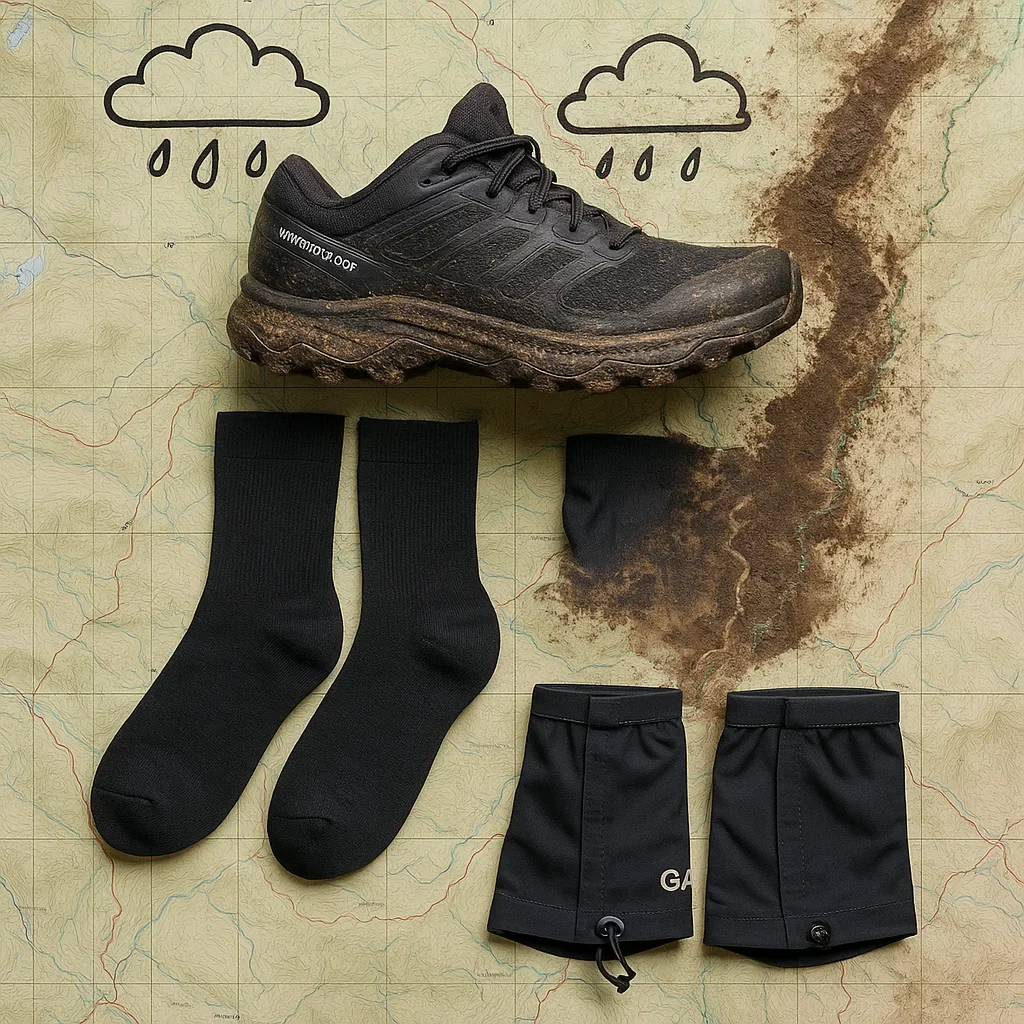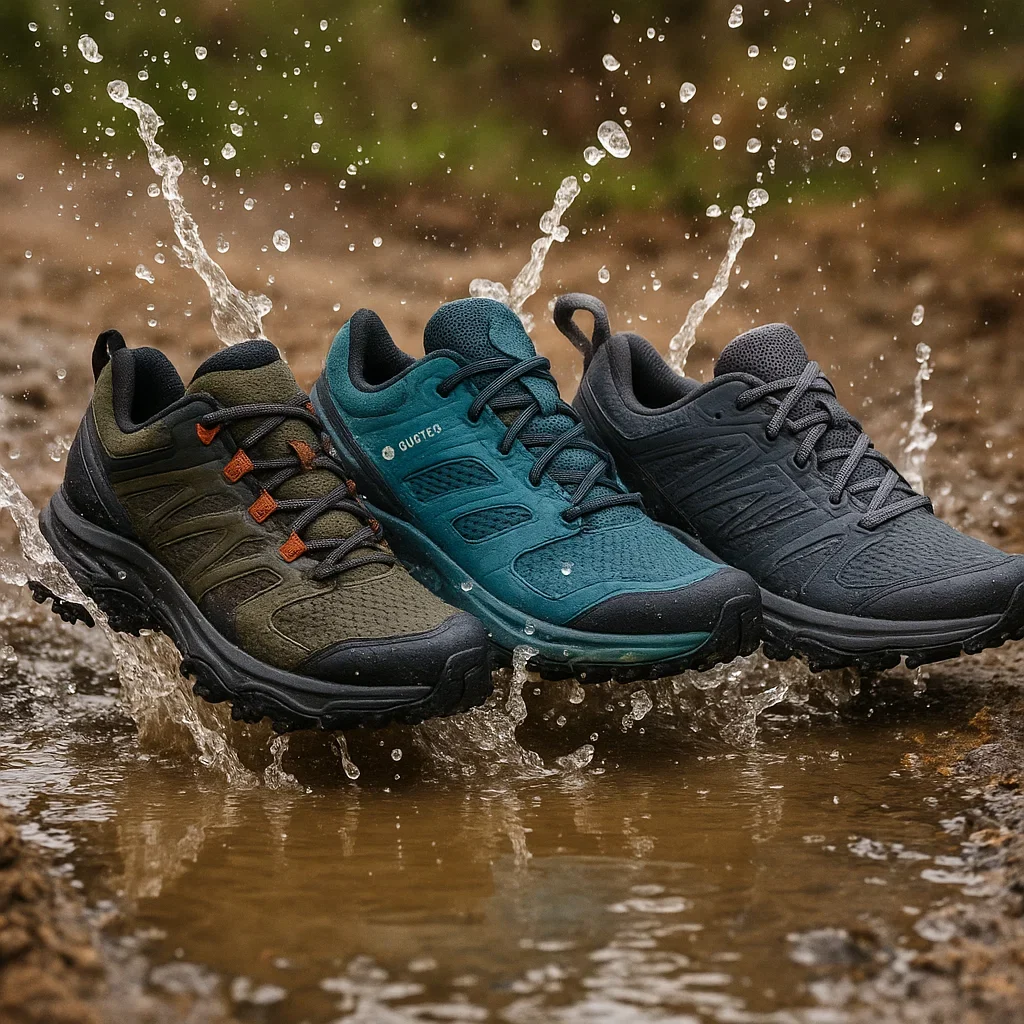Do you really need waterproof trail shoes for a 100K ultra marathon?
This is the ultimate decision guide—dive deep into the pros and cons, user stories, technical insights, decision charts, and get ready for every puddle, creek, or rainstorm!
- Pros: Dry feet in heavy rain, wet grass, creek crossings. Fewer blisters (sometimes), more comfort in winter/cold.
- Cons: Poor breathability in summer, hot feet, heavier when soaked, slow drying if water gets in, less flexibility.
- Key Decision: Are your 100K races usually wet, muddy, cold—or hot, dry, and technical?
🏷️ Waterproof vs Mesh Trail Shoes – 100K Ultra Comparison
| Feature | Waterproof Shoe | Mesh (Non-Waterproof) |
|---|---|---|
| Weight | +20–40g (heavier) | Lighter |
| Breathability | Lower (hot feet risk) | High (cools/drys fast) |
| Wet Protection | Excellent (keeps rain out) | Poor—feet get wet fast |
| Drying Speed | Very slow if soaked inside | Drains and dries rapidly |
| Comfort in Cold | Great (warmth) | Needs thicker socks |
| Best For | Wet, muddy, cold, long snow/rain | Hot, dry, stream-crossings, summer |
🧭 Decision Chart: Is Waterproof Your Best Bet?
- Is the forecast wet, cold, or muddy? → Yes: Consider waterproof models.
- Do you sweat heavily or race in summer? → No: Prefer mesh for breathability.
- Are you a slow/steady finisher (over 18h)? → Yes: Waterproof may help keep feet warm.
- Lots of creek crossings? → No: Mesh shoes drain faster after submersion.
- Prone to cold toes or winter races? → Yes: Waterproof + merino socks is a good combo.
- Do you blister easily in heat? → Yes: Go mesh, dry fast, and change socks!

🌧️ Runner Stories: Wet, Wild & 100K—Did Waterproof Work?
– Alex, rainy ultra finisher
– Brooke, mountain ultrarunner
– Tomas, cold weather specialist
- Check the course map: Streams, river crossings, persistent mud?
- Study race-day weather: Rain expected over several hours?
- Pack backup socks: Even waterproof shoes can leak eventually—fresh socks help.
- Bring gaiters: Especially if you use mesh shoes in mud or sand.
- Try on both types: Test during wet, cold, and warm runs before race day.
- Don’t rely solely on “waterproof” claims—read reviews, test yourself!
🔗 Explore More 100K Ultra Shoe Guides
❓ Advanced FAQ: Waterproof Trail Shoes for 100K Ultra Marathons
💧 Are waterproof shoes truly waterproof?
Mostly—they block rain, mud, and shallow puddles. But water entering from the ankle collar will not drain out. In heavy rain or deep water, no shoe is 100% dry forever.
🌞 Are waterproof shoes bad for hot weather?
Yes, they trap heat and sweat. In hot climates or summer races, mesh shoes are almost always better for comfort and blister prevention.
👣 Do waterproof shoes prevent blisters?
They can help if the alternative is feet soaked for hours in cold rain. But trapped sweat in warm races can also cause blisters—always use moisture-wicking socks.
🧦 What socks work best with waterproof trail shoes?
Thin, synthetic, or merino wool socks are ideal—avoid cotton. Carry dry socks to swap at aid stations, especially if water does get in.
🔄 Should I bring both waterproof and mesh shoes to a 100K?
Yes, if your race allows drop bags or crew access. Start in waterproof if it’s raining, switch to mesh as conditions dry, or keep mesh as a backup in case your feet overheat or flood.
🧼 Care & Durability: Get the Most from Your Waterproof Shoes
- Rinse and air dry after every muddy or wet race—never use direct heat.
- Open laces fully and remove insoles to dry faster.
- Inspect for seam leaks or membrane damage—tiny holes can ruin waterproofing.
- Pair with trail gaiters to keep out grit and splashes from the ankle collar.
- Alternate with mesh shoes in training to reduce wear and prevent odor buildup.
- Reproof the outer fabric (if needed) with waterproof sprays—follow brand recommendations.
🏆 Pro Tips & Pitfalls: Waterproof Shoes for 100K in the Real World
- Tip: For cold ultras, pre-warm shoes and socks in a dry bag at the start line.
- Tip: Practice fast sock changes—blister-free feet win ultras!
- Mistake: Assuming “waterproof” means invincible—ankle-deep river crossings will flood any shoe.
- Mistake: Not training in both types—find out if your feet overheat or get too cold in each model before race day.
- Bonus: Always carry a small pack towel or synthetic chamois in your drop bag to dry feet quickly if needed.
📚 Further Reading & Related Guides
Share This Guide!
Final Thoughts
Waterproof shoes are a tool—not a miracle. They can save your feet in cold, muddy, and rainy 100K races, but also trap heat or water if conditions change. Test both mesh and waterproof, use the right socks, and always plan for mid-race changes. The best finish is the one where your feet are happy!

About the Author
Lost Pace is an ultramarathon runner, shoe-tester and the founder of umit.net. Based year-round in Türkiye’s rugged Kaçkar Mountains, he has logged 10,000 + km of technical trail running and completed multiple 50 K–100 K ultras.
Blending mountain grit with data, Lost analyses power (CP 300 W), HRV and nutrition to craft evidence-backed training plans. He has co-written 260 + long-form guides on footwear science, recovery and endurance nutrition, and is a regular beta-tester of AI-driven coaching tools.
When he isn’t chasing PRs or testing midsoles, you’ll find him sharing peer-reviewed research in plain English to help runners train smarter, stay healthier and finish stronger.
Ultrarunner · Data geek · Vegan athlete
❓ Advanced FAQ: Waterproof Trail Shoes for 100K Ultra Marathons
💧 Are waterproof shoes truly waterproof?
🌞 Are waterproof shoes bad for hot weather?
👣 Do waterproof shoes prevent blisters?
🧦 What socks work best with waterproof trail shoes?
🔄 Should I bring both waterproof and mesh shoes to a 100K?
🧼 Care & Durability: Get the Most from Your Waterproof Shoes
- Rinse and air dry after every muddy or wet race—never use direct heat.
- Open laces fully and remove insoles to dry faster.
- Inspect for seam leaks or membrane damage—tiny holes can ruin waterproofing.
- Pair with trail gaiters to keep out grit and splashes from the ankle collar.
- Alternate with mesh shoes in training to reduce wear and prevent odor buildup.
- Reproof the outer fabric (if needed) with waterproof sprays—follow brand recommendations.
🏆 Pro Tips & Pitfalls: Waterproof Shoes for 100K in the Real World
- Tip: For cold ultras, pre-warm shoes and socks in a dry bag at the start line.
- Tip: Practice fast sock changes—blister-free feet win ultras!
- Mistake: Assuming “waterproof” means invincible—ankle-deep river crossings will flood any shoe.
- Mistake: Not training in both types—find out if your feet overheat or get too cold in each model before race day.
- Bonus: Always carry a small pack towel or synthetic chamois in your drop bag to dry feet quickly if needed.
📚 Further Reading & Related Guides
Share This Guide!
Final Thoughts
Waterproof shoes are a tool—not a miracle. They can save your feet in cold, muddy, and rainy 100K races, but also trap heat or water if conditions change. Test both mesh and waterproof, use the right socks, and always plan for mid-race changes. The best finish is the one where your feet are happy!

About the Author
Lost Pace is an ultramarathon runner, shoe-tester and the founder of umit.net. Based year-round in Türkiye’s rugged Kaçkar Mountains, he has logged 10,000 + km of technical trail running and completed multiple 50 K–100 K ultras.
Blending mountain grit with data, Lost analyses power (CP 300 W), HRV and nutrition to craft evidence-backed training plans. He has co-written 260 + long-form guides on footwear science, recovery and endurance nutrition, and is a regular beta-tester of AI-driven coaching tools.
When he isn’t chasing PRs or testing midsoles, you’ll find him sharing peer-reviewed research in plain English to help runners train smarter, stay healthier and finish stronger.
Ultrarunner · Data geek · Vegan athlete

